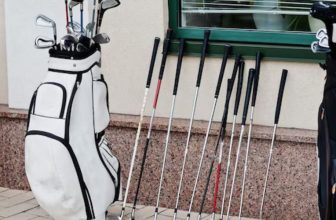
Golf balls are not all alike. In fact, there are many different types of golf balls on the market, each with its own unique set of features. But how do you know which golf ball is right for you? And what are the differences between all of the different types of golf balls?
One of the most important things to consider when choosing a golf ball is the number of dimples it has. Why? Because the dimples on a golf ball have a big impact on its flight. The dimples help to create lift and spin, which in turn affects the trajectory and distance of your shots.
So, how many dimples does a typical golf ball have? It depends on the type of golf ball. Most golf balls have between 300 and 500 dimples, but there are some that have as many as 1,000 dimples. The dimples on a golf ball can also vary in size. Some are very small, while others are larger.
The number of dimples on a golf ball can make a big difference in your game. If you’re looking for more distance, you might want to choose a golf ball with fewer dimples. If you’re looking for more control, you might want to choose a golf ball
Contents
How do dimples improve a golf ball’s performance?
When it comes to golf, every little bit counts. That’s why some golfers are willing to do whatever it takes to get an edge on the competition, even if it means resorting to some, shall we say, unconventional methods. Case in point: dimples on a golf ball.
Yes, those tiny little indentations on a golf ball can actually make a big difference in how the ball performs. Dimples help to reduce the amount of drag on the ball as it flies through the air, which in turn makes the ball fly further and with more accuracy.
So how do dimples work? It all has to do with the Bernoulli principle. This principle states that when a fluid (in this case, air) flows over a surface, the areas of the surface where the fluid flows more quickly have less pressure than the areas where the fluid flows more slowly.
So, when a golf ball with dimples is hit, the air flow over the surface of the ball is disrupted, which causes the pressure on the ball to be uneven. This uneven pressure creates a lifting force on the ball that helps it to fly further and with more accuracy.
So there you have it. The next time you’re out on the golf course, don’t be afraid to give those dimpled balls a try. They just might help you take your game to the next level.
Do all golf balls have dimples?
While the dimple pattern on a golf ball may look random, each dimple is actually carefully placed to optimize the ball’s flight. Dimples help reduce drag on the ball as it flies through the air, which results in a longer, straighter shot. Dimples also help keep the ball stable in windy conditions.
There are several different dimple designs, and each golf ball manufacturer has their own proprietary design. The number of dimples on a golf ball can also vary, but most golf balls have between 300 and 500 dimples.
So, do all golf balls have dimples? The answer is yes! Dimples are an essential part of a golf ball’s design and performance.
How are dimples created on a golf ball?
Golf balls are dimpled to create an aerodynamic effect that makes the ball travel further. The dimples on a golf ball help to create turbulent flow around the ball which in turn decreases the drag force on the ball. This allows the ball to travel further through the air and results in more accurate shots.
The dimples on a golf ball also help to create spin. When a golf ball is hit, the dimples cause the ball to rotate. This spin helps to keep the ball on its intended path and also adds to the distance that the ball can travel.
There are a variety of dimple patterns that can be found on golf balls. The most common dimple pattern is the pentagon. This dimple pattern is made up of five small dimples that are evenly spaced around the ball.
Dimples are created on a golf ball by first molding the ball into its desired shape. Once the ball has been molded, small indentations are made on the surface of the ball. These indentations are then filled with a rubber compound and left to cure.
Once the rubber compound has cured, the ball is then ready to be used. The dimples on the ball will help to create a more aerodynamic effect and also add spin to the ball. This will help to improve the accuracy and distance of your shots.
Are there any drawbacks to having dimples on a golf ball?
Are there any drawbacks to having dimples on a golf ball? This is a question that I have been asked a lot lately. There are a few drawbacks to having dimples on a golf ball. The main one is that they can cause the ball to spin more. This can be a problem if you are trying to hit a straight shot. Dimples can also make the ball fly further, but this is usually not a problem for most golfers. Another drawback is that dimples can make the ball harder to control. If you are a beginner, you may want to avoid balls with dimples.
How does the number of dimples on a golf ball affect its flight?
When it comes to dimples on a golf ball, there is no definitive answer as to how many dimples affect its flight. There are many factors that come into play such as the type of terrain, the club used, and the player’s own strength and technique. However, some say that the number of dimples on a golf ball can affect its flight, specifically the lift and drag forces.
It is believed that the dimples on a golf ball help to create a turbulent boundary layer of air flow around the ball. This turbulence helps to reduce the amount of drag on the ball, which in turn, helps to increase the lift. The lift-to-drag ratio is what determines how far and how high a golf ball will fly. A higher ratio means the ball will fly further and higher, while a lower ratio means the ball will not fly as far.
Some argue that the number of dimples on a golf ball does not affect the lift-to-drag ratio and, therefore, has no effect on the ball’s flight. However, others believe that the number of dimples can indeed affect the flight of a golf ball. So, what is the truth?
The answer may lie in the fact that there is no one definitive answer. It is possible that the number of dimples on a golf ball can affect its flight, but there are so many other factors that come into play that it is difficult to say for certain. If you are looking to improve your game, it is best to focus on your own technique and strength, as well as the type of terrain and club you are using.
Can the dimple on a golf ball be customized?
There’s no mistaking a golf ball’s dimple pattern. That distinctive texture helps the ball cut through the air and spin for added control and accuracy. But did you know that the dimple design on a golf ball is not random? In fact, it’s the result of careful engineering and testing to ensure that the ball performs optimally in flight.
So, what exactly goes into designing a golf ball’s dimple pattern? And can the dimples on a golf ball be customized? Let’s take a closer look.
The Science of Dimples
Golf balls have dimples because they help the ball fly further and straighter than a smooth ball. The dimples create turbulence in the air around the ball, which reduces drag and keeps the ball in the air longer.
Dimples also affect the ball’s spin rate. When a ball hits the ground, the dimples on the bottom of the ball cause it to spin. The faster the ball spins, the more control a golfer has over its trajectory.
Designing the Perfect Dimple Pattern
So, how do manufacturers decide what dimple pattern to use on a golf ball? It’s a combination of science and trial and error.
engineers use computational fluid dynamics (CFD) to simulate how different dimple patterns affect the flight of a golf ball. CFD is a powerful tool that lets engineers see how air flows around an object in a virtual environment.
Once they have a general idea of how a dimple pattern will affect the ball’s flight, manufacturers test the pattern on a prototype golf ball. They use high-speed cameras and launch monitors to track the ball’s flight and gather data about its performance.
Based on the data, they make adjustments to the dimple pattern and test it again. This process is repeated until they find a dimple pattern that gives the ball the desired flight characteristics.
Can You Customize a Golf Ball’s Dimple Pattern?
The short answer is yes, you can customize the dimple pattern on a golf ball. However, it’s important to note that there are no regulations governing the dimple patterns on golf balls. This means that any dimple pattern can be used, regardless of how it affects the ball’s flight.
Some companies offer golf balls with custom dimple patterns. These companies use CFD and launch monitors to design dimple patterns that they believe will improve the ball’s performance.
However, it’s important to remember that there is no guarantee that a custom dimple pattern will improve your game. Ultimately, it comes down to personal preference and finding a golf ball that you’re comfortable with.
If you’re curious about trying a golf ball with a custom dimple pattern, do your research and make sure you’re buying from a reputable company. And don’t forget to test the ball before you commit to using it in a tournament.
How long do dimples last on a golf ball?
Golf balls are designed to dimple in order to create a more aerodynamic flight. Dimples help reduce drag on the ball as it flies through the air, which ultimately results in a straighter, longer shot. While the dimples on a golf ball may eventually wear down over time, they should last for several rounds of play before needing to be replaced.
What happens if a golf ball loses its dimples?
If a golf ball loses its dimples, it will not be able to fly as far. The dimples on a golf ball help to create lift, which in turn allows the ball to fly further.
Do professional golfers prefer golf balls with dimples?
When it comes to golf balls, dimples are definitely in. Most professional golfers prefer golf balls with dimples because they help to reduce spin and improve accuracy. Dimples also help to add distance to your shots.
There are a few different theories as to why dimples help improve a golf ball’s performance. One theory is that dimples help to create a thin layer of turbulent air around the ball. This turbulent air helps to reduce drag on the ball, which in turn, helps to add distance to your shots.
Another theory is that dimples help to create a more stable flight path for the ball. When a golf ball is hit, it starts to spin. The faster it spins, the more unstable its flight path becomes. Dimples help to reduce spin and stabilize the ball’s flight path, which leads to more accurate shots.
So, why do professional golfers prefer golf balls with dimples? There are a few different theories, but the bottom line is that dimples help to improve a golf ball’s performance. Dimples help to reduce spin, stabilize the ball’s flight path, and add distance to your shots. If you’re looking to improve your game, then golf balls with dimples are definitely the way to go.







